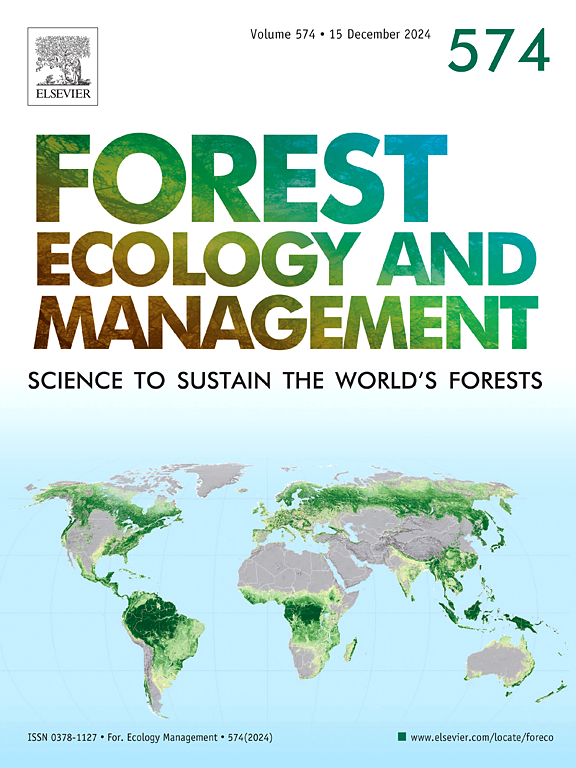性状介导的邻域互补促进温带森林树木生长
IF 3.7
2区 农林科学
Q1 FORESTRY
引用次数: 0
摘要
量化邻域功能组成对邻域树木性能的影响有助于阐明森林生态系统形成的过程。根据生态位互补(绝对性状距离ATD,非方向性)和竞争等级(等级性状距离HTD,方向性)假设,性状可以调节邻居的生态位和适合度差异。然而,人们对这些假设在塑造森林树木群落邻里动态中的重要性知之甚少,特别是基于性状的生态位互补和竞争等级如何影响种内和种间相互作用,从而调节邻近树木的生长。为了解决这一知识空白,我们在中国温带森林进行了实地研究,重点研究了红松(Pinus koraiensis)和榆树(Ulmus laciniata)。具有不同功能性状和资源利用策略的两种优势树种。红松采取保守策略,具有资源利用效率慢、抗逆性强等功能性状。相比之下,榆树采用了一种获取策略,其特征与高资源吸收和高环境敏感性有关。结果表明,两种植物的生长速率均随ATD的增加而增加,而HTD的增加没有影响。具体来说,种间互补性(ATDinter)对焦点树生长有积极影响,而种内互补性(ATDintra)仅对获得性物种有影响。ATDinter和ATDintra均与非生物变量相互作用,影响获取型物种的生长,而保守型物种的邻域互补效应强度不受非生物环境的影响。我们的研究结果表明,个体树木的表现可能受到社区相互作用的调节,这种相互作用取决于种内和种间性状差异、资源利用策略、社区密度和环境条件。这对地方或以个人为基础的森林管理以及从个人绩效到森林生态系统的以性状为基础的生态学都有影响。本文章由计算机程序翻译,如有差异,请以英文原文为准。
Trait-mediated neighborhood complementarity promotes tree growth in a temperate forest
Quantifying the effect of neighborhood functional composition on the performance of neighboring trees can help elucidate the processes of forest ecosystem formation. Traits may mediate niche and fitness differences of neighbors, as predicted by the niche-complementarity (absolute trait distance ATD, non-directional) and competitive-hierarchy (hierarchical trait distance HTD, directional) hypotheses. However, there is little understanding of the importance of these hypotheses in shaping neighborhood dynamics of forest tree communities, especially how trait-based niche complementarity and competitive hierarchy affect intra- and interspecific interactions, which regulate the growth of neighboring trees To address this knowledge gap, we conducted a field study in a temperate forest in China, focusing on Pinus koraiensis and Ulmus laciniata, two dominant tree species with distinct functional traits and resource-use strategies. Pinus koraiensis adopts a conservative strategy, characterized by functional traits such as slow resource-use efficiency and strong stress tolerance. In contrast, Ulmus laciniata employs an acquisitive strategy, typified by traits associated with high resource uptake and high environmental sensitivity. Our results showed that growth rates of both species increased with ATD, but not HTD. Specifically, interspecific complementarity (ATDinter) positively influenced focal tree growth, whereas intraspecific complementarity (ATDintra) did so only for the acquisitive species. Both ATDinter and ATDintra interacted with abiotic variables to affect the growth of acquisitive species, whereas the strength of the neighborhood complementarity effects did not vary with abiotic environment for the conservative species. Our findings suggest that the performance of individual trees may be regulated by neighborhood interactions that depend on intra- and interspecific trait differences, resource-use strategies, neighborhood density, and environmental conditions. This has implications for local or individual-based forest management, as well as for trait-based ecology from individual performance to forest ecosystem.
求助全文
通过发布文献求助,成功后即可免费获取论文全文。
去求助
来源期刊

Forest Ecology and Management
农林科学-林学
CiteScore
7.50
自引率
10.80%
发文量
665
审稿时长
39 days
期刊介绍:
Forest Ecology and Management publishes scientific articles linking forest ecology with forest management, focusing on the application of biological, ecological and social knowledge to the management and conservation of plantations and natural forests. The scope of the journal includes all forest ecosystems of the world.
A peer-review process ensures the quality and international interest of the manuscripts accepted for publication. The journal encourages communication between scientists in disparate fields who share a common interest in ecology and forest management, bridging the gap between research workers and forest managers.
We encourage submission of papers that will have the strongest interest and value to the Journal''s international readership. Some key features of papers with strong interest include:
1. Clear connections between the ecology and management of forests;
2. Novel ideas or approaches to important challenges in forest ecology and management;
3. Studies that address a population of interest beyond the scale of single research sites, Three key points in the design of forest experiments, Forest Ecology and Management 255 (2008) 2022-2023);
4. Review Articles on timely, important topics. Authors are welcome to contact one of the editors to discuss the suitability of a potential review manuscript.
The Journal encourages proposals for special issues examining important areas of forest ecology and management. Potential guest editors should contact any of the Editors to begin discussions about topics, potential papers, and other details.
 求助内容:
求助内容: 应助结果提醒方式:
应助结果提醒方式:


